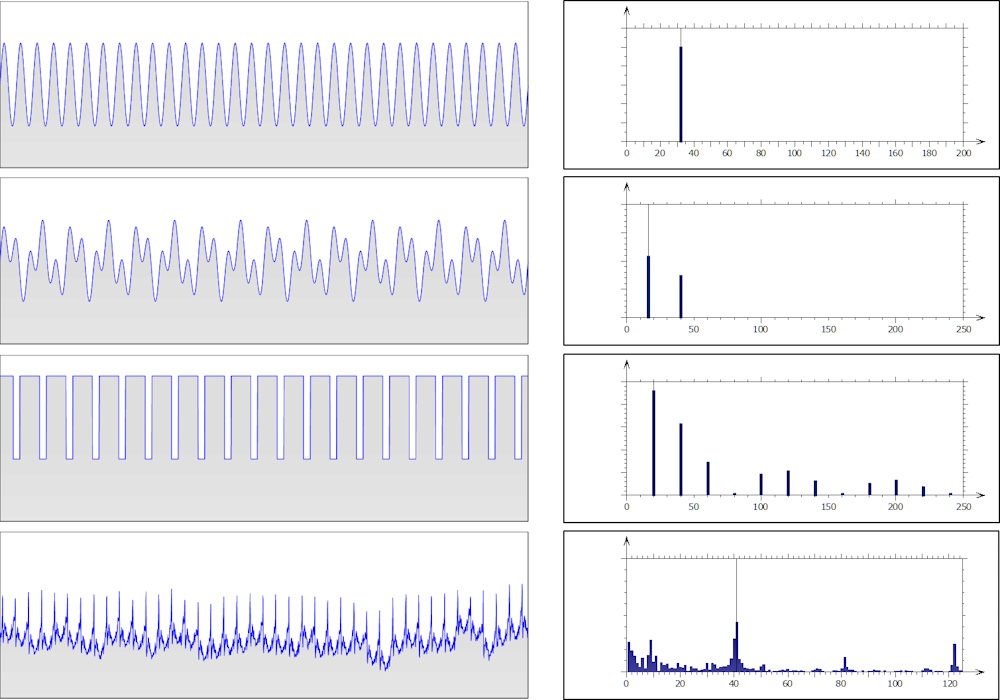What is Spectral Analysis?
Spectral analysis is closely related to filtration. It is important to understand the basics of signal processing as it is a building block of many surface texture analysis tools. This page walks you through the main concepts and applications, including spectral analysis and filtration.
1. Basics of signal processing
Performing spectral analysis on a signal means examining its content in terms of frequencies (or wavelengths).
The simplest signal is a sine wave, which is defined by its wavelength, amplitude and phase. Wavelength defines the length of an oscillation in the spatial domain (it is given in µm, nm or any length unit). If this wave propagates at a particular speed (noted ν and expressed in m/s) then you can define its frequency f = ν/λ, which is proportional to the inverse of the wavelength λ.
In surface texture, signals represent profiles or surfaces, so it is convenient to use wavelengths instead of frequencies, as signals are in the spatial domain.

The three parameters that define a sine wave: amplitude a, wavelength λ, phase Φ.
2. Analysis of the spectral content of a signal
To switch from the spatial domain to the spectral domain, or vice-versa, we use a Fourier transform, usually via an FFT algorithm which is fast and optimized. The spatial description of a profile or a surface, and their spectrum, are two different ways of describing the same object. They are dual representations.
The usual representation of a spectrum is either a 1D graph that represents amplitudes in function of the frequency index, for a profile, or an image that represents amplitudes in color, in function of the X/Y indices of the 2D spectrum. By looking at the spectrum of a signal, it is possible to identify periodic waves, as they appear as peaks on a 1D spectrum or white pixels on a 2D spectrum.
Peaks can represent actual structures on the surface, such as the periods of a periodical material measure, or they can be spurious oscillations that may come from vibrations or electrical frequency leaking due to the power supply (50 or 60 Hz).

The figure here shows several profiles and their corresponding spectrum. The spectrum of a perfectly sinusoidal wave will, by definition, consist of a single spectral ray, since its Fourier series decomposition only has one term. A signal composed of two sinusoids at different frequencies and amplitudes will show a spectrum consisting of two spectral rays. A slightly more complex signal, such as a periodic square with a non-symmetrical duty cycle, gives a spectrum consisting of the fundamental frequency and complementary harmonics, all of which are multiples of the main frequency.
Finally, in the case of a real periodic profile, which contains irregularities, we find the main frequency and its harmonics, but also other smaller rays around it, which represent the irregularities of the profile.
Introduction to Filtration and Spectral analysis
This video explains how surface metrology filters work and their effect on signals (profiles and surfaces). These notions are key to understand surface texture analysis. Duration : 19 min 57.
3. Filtration
The aim of a filter is to attenuate part of the spectrum and transmit the other part. For example, by attenuating long wavelengths in a primary profile, above a cut-off value (λc or Nic), we obtain the roughness profile. It is then an L-filter (or a high-pass filter). A microroughness filter that removes the shortest wavelengths below λs (or Nis) is a S-Filter.
Different filters (Gaussian, Spline, Robust Gaussian) have different frequency response curves but are all based on the same principles and the same actions on the spectrum. These filters are described in the standard series ISO 16610.
4. Software tools for spectral analysis
In Mountains® software, several operators and studies allow the analysis or modification of the spectrum. The Filter the spectrum operator allows the user to interactively remove spectral content from the spectrum. The Threshold the spectrum operator is an easy way to reduce noise by removing spurious frequencies.
The Frequency spectrum study displays the spectrum with a cursor to check the amplitude and phase of a particular spectral peak. The Averaged Power Spectrum Density study provides a better look at long wavelengths, and has a mode for evaluating the PSD for optical applications. Many other features are also available.
Other spectral analysis features are also available in Mountains®. Visit the pages on Mountains® and on the optional modules.
